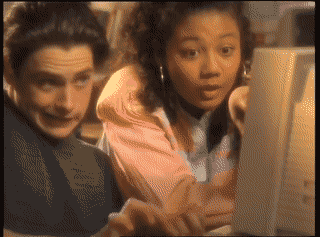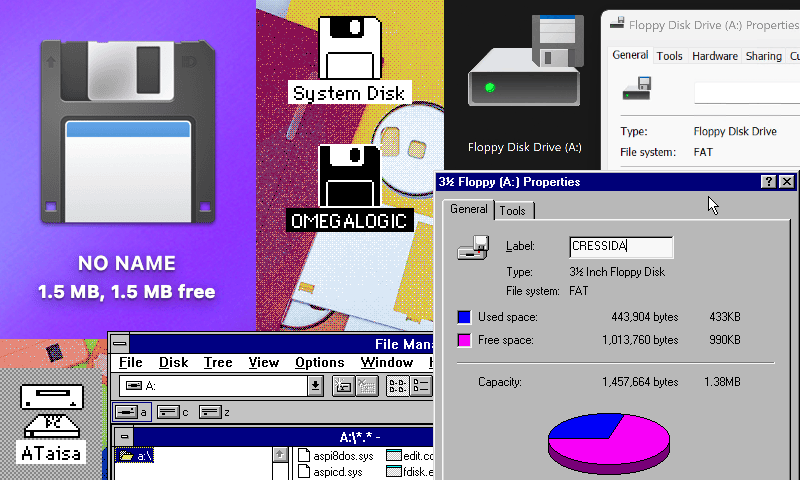Copy That Floppy

Floppy disks, or diskettes. Well, not exactly floppy—the ones I used mostly were rigid. But they started floppy! The first ones before my time introduced by IBM in 1971 were thin, floppy, and at 8″ in diameter, they were almost as big and functional as uchiwa, round Japanese hand fans.


In 1976, they went down to 5¼″, and both sides of the disk instead of just one could hold data, increasing the capacity from the original 80 KB to 180 KB. Later, in 1982, the year I was born, came the first 3½″, floppy disks, with even more room for storage, which were actually in a solid case. But who’s gonna want to call them rigid or solid disks?
While I was in school, I carried a few floppies on me everywhere I went. As I described before, I was editing HTML files on some old computer with no hard disk, and save them on floppies. When I had access to a computer connected to the Internet, I’d take the chance to upload the files online to my website on GeoCities.




My floppies didn’t just have HTML files. Like I said, since I didn’t have a hard drive or other means of saving data. I had one particular disk, The Floppy, with my diary written in plain text, contact details of my friends in person and online, as well as the HTML files I mentioned earlier, and batch files I wrote to help me manage them or prep any computer I was about to use. The data was filling up the “High Density” 1.44 MB capacity of the floppy, which is laughable today, but back then, it meant everything to me. (Yup, even 40 years ago, I was writing script files!)
I even had picture collections on floppies! The early MAVICA camera by Sony was using floppy disks to store digital pictures in JPEG format. My school had one, and as I was on their webpage committee, they let me use it. I even snuck it home a few times. Take a shot and you’d hear the drive whirl to save the photo. I’ll try to find some old photos I took with it and talk about the camera another time.
3½″ floppies were everywhere. Internet access wasn’t common yet, and neither were CD-ROMs, so all the software came on it. I even remember painfully installing Windows 95 from a series of 13 numbered floppy disks. The medium even made it into musical fame in a PSA with a rapper advising people not to pirate software.


Today, in 2025, we can say floppy disks are dead…
Or, can we?
Back in 2014, a visit in the control room of the Vancouver SkyTrain revealed they were still using a floppy disk to boot up a system. In Japan, just last year, the government finally amended laws requiring the use of floppy disks for submitting paperwork. It seems every time we think the floppy is dead, we can find old synths, embroidery machines, medical and scientific gear, or some other device out there that still needs it.
These days, people call it a “save icon.” In the days of the floppies, they were used as symbols on user interfaces to represent saving a file, and somehow that image never faded, transcending even floppies themselves.
As you can see, floppies may be passé, but they’re still around. Some even use them as musical instruments!
Although, even as people found playful new uses, the industry was moving on.


Apple had a peculiar relationship with floppy disks. At first, they made them cool. The Macintosh was the only computer I know which had drives that made floppy disks work like VHS tapes or CDs: you inject the floppy, and then when you’re done with it, you could drag it into the Trash bin, and the computer would eject the disk mechanically.
But then, with the release of their first iMac, Apple killed the floppy. No more floppy disk drive—it was just gone. Time to move on…
Yet, they didn’t anticipate their colourful plastic iMac to start a trend of colourful translucent products. Even floppy disk manufacturers joined the fad. Floppies now on life support, which used to come in dull shades of grey and black, were available in rainbow shades of almost-edible red, blue, green, yellow, and purple. I loved those! I even found a few boxes of them online and actually bought them at more than their original price—I guess the nostalgia or retro tax—just to take pictures of them for this article.



One thing people could never seemed to figure out: when facing the front side of a floppy, should the label point up or down? To many, it wasn’t obvious. It was a debate like the one about whether a toilet paper roll should face inward or outward. The consensus on that is outward, and for the label, it should be pointing down. Yet, people still like to argue, despite the “HD” symbol on the floppy itself showing the right direction. I guess some people thought it was “CH.”
That said, operating systems will each show those “save icons” with labels in different directions. In any case, I’m just surprised they are still supported and there are drives still available to read them, plugged via USB. In Windows, it’s still the A: drive.

It’s a shame the change of capacity in floppies didn’t catch on as much as their fashion overhaul! IBM made “Extended Density” 2.88 MB floppies in the late 90s, but by then, Zip drives using floppies with hundreds of megabytes and CD burners were becoming en vogue.
I had stacks of floppies, on which I’d archive downloads, pictures, webpages, and other old files. It was possible to store data in Zip or RAR files that spans across multiple discs. That was practical, until you started having dozens, or maybe hundreds, of megabytes to save, onto tall stacks of floppies. It was okay, but quickly, you saw some disks were starting to fail. Sometimes, you’d forget to label them, so good luck finding the right order of the floppies to put in when retrieving your files.
Eventually, I had access to a CD burner, and soon enough, I ditched 1.44 MB floppies to store my stuff onto shiny 650 MB discs.


Now, while CDs are still around, who do you know that still uses them for keeping files? Data storage is readily available these days: I have a 1 TB USB flash key with me everywhere I go, 1 TB of storage on my smartphone, even more on my NAS file server at home and in the cloud… Finding space to store your files is far from being problematic as it used to be.
I may be fancy with all my terabytes of storage capacity today. But today, I wanted to pay homage to the first medium that saved the text files I deemed closest to my heart. Hearing in my head the echoes from the ’90s—its drive whirling and spinning, making the thin magnetic disc in the rigid plastic casing come to life—and seeing its little glyph on my smartphone today before I tap it to keep a file, I will always honour the 3½″ floppy disk.
No matter how much storage I carry in my pocket, that little 💾 will always remind me of the first time my words had a place to live.
